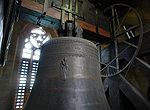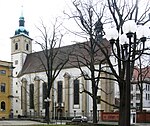Erfurt Cathedral

Erfurt Cathedral (German: Erfurter Dom, officially Hohe Domkirche St. Marien zu Erfurt, English: Cathedral Church of St Mary at Erfurt), also known as St Mary's Cathedral, is the largest and oldest church building in the Thuringian city of Erfurt, central Germany. It is the episcopal seat of the Roman Catholic Diocese of Erfurt. The cathedral was mainly built in the International Gothic style and is located on a hillside overlooking the main town square (Domplatz, Cathedral Square), directly next to St Severus' Church. As a unique architectural ensemble, both churches together form the city's landmark. Former German names include Marienkirche and Propsteikirche Beatae Mariae Virginis.
Excerpt from the Wikipedia article Erfurt Cathedral (License: CC BY-SA 3.0, Authors, Images).Erfurt Cathedral
Domstufen, Erfurt Altstadt
Geographical coordinates (GPS) Address Phone number Website External links Nearby Places Show on map
Geographical coordinates (GPS)
| Latitude | Longitude |
|---|---|
| N 50.9759 ° | E 11.0233 ° |
Address
Erfurter Dom (Propsteikirche Beatae Mariae Virginis;Hohe Domkirche St. Marien zu Erfurt)
Domstufen 1
99084 Erfurt, Altstadt
Thuringia, Germany
Open on Google Maps










